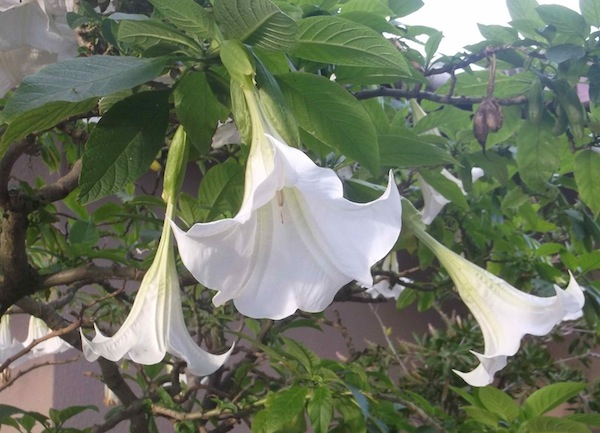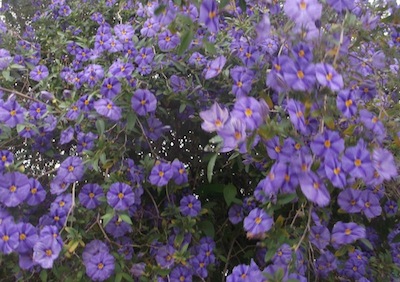Prevent cross infection in your garden
know your nightshade plants
This article will overview the nightshade plants, or the botanical family Solanaceae.
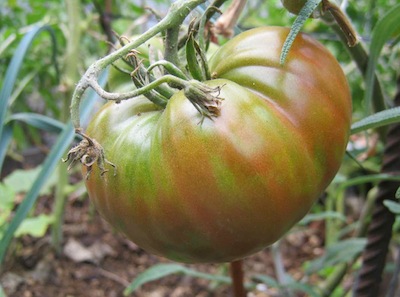 on of the easiest to grow and globally successful nightshade vegetables, the tomato
on of the easiest to grow and globally successful nightshade vegetables, the tomatoThe images on this page feature nightshade plants in my neighborhood and my own garden. Additional pictures collected on Pinterest give an idea of the eye popping diversity of this plant group, from exquisite flowers to deadly poisons, hallucinogens, and a mind boggling assortment of chilies and tomatoes.
During my journey I also discovered some interesting nightshade vegetables and fruit I had never heard of before.
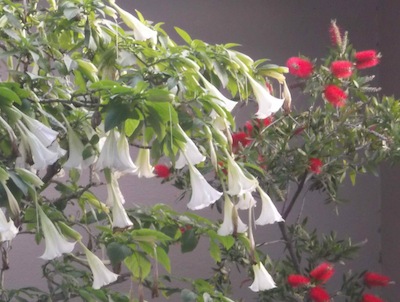 Brugmansia candida Brugmansia candida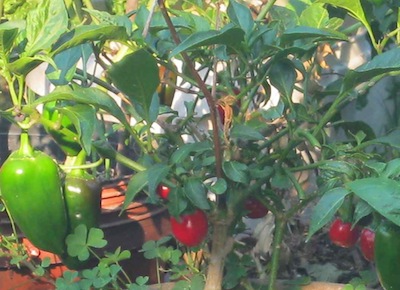 Capsicum annuum Capsicum annuum |
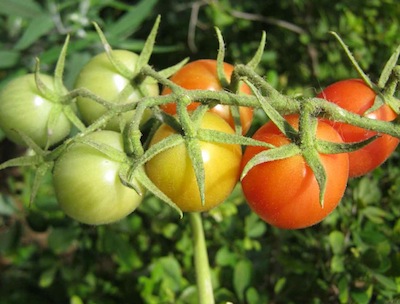 Solanum lycopersicum Solanum lycopersicum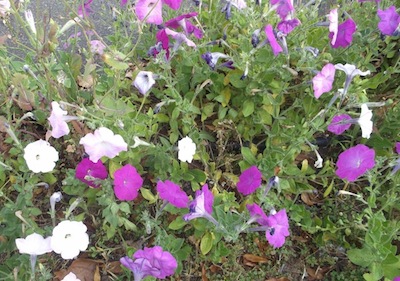 Petunia sp. Petunia sp. |
Some of the common nightshade plants
I started with the intention of forming a list of nightshade plants, familiarizing myself with the common or garden members of the nightshade family as well as the diversity of the nightshades in order to avoid having them near my tomatoes and potatoes, which also belong in the family Solanaceae. I already intend practicing crop rotation to stop the cycle of disease, but I need knowledge of the nightshade plants to do this properly, in case I plant a flower nearby or neglect a weed in my garden, that without my knowledge, belongs to the family of nightshade plants.
Why you must know your nightshade plants
The necessity of this I discovered during research on tomato diseases. All Solanaceae, or nightshade plants, can transfer early blight. The family relationship can also lead to common insect pests. In some scientific research it has been found that plant chemistry drives the specialization of insect herbivores. Host specialization is driven by adaption to ingesting the secondary metabolites of plants (Futuyama and Moreno 1988), (Schoonhoven et al. 2005). The plants studied were in the Solanum genus: S. suaveolens and S.ursinum. The genus Solanum is characterized by the presence of steroidal alkaloids (Eich 2008) that have driven insect adaption.
Where the nightshade plants fit in botanical groupings
The related group of plants above the Solanaceae, is the larger plant order Solanales, which includes another large family related to the Solanaceae, the Convolvulaceae, or morning glory and its relatives, and a few smaller families. The Solonales belong under the Asterids, then the Eudicots and the Angiosperms.
Under the Solanaceae are three major subfamilies, the Petunioideae (Petunias and relatives), Solanoideae (Nightshades) and Nicotianoideae (tobacco family).
The splendour of the Solanaceae
I was astounded by the diversity of the Solanaceae, as I associated the name with South America and a few vegetables I knew like potatoes, tomatoes, chilis and eggplant. I discovered amazing new South American fruits and other food uses for nightshade plants on my birth continent Africa (so proud of that. She never ceases to enlighten me), as well as a diversity of flowers and drugs found around the world.
The 2800 species of nightshade plants are distributed worldwide, on all continents except Antarctica, and in the other continents are only absent from two deserts, regions in the Sahara and the Eastern province of Saudi Arabia. The mega-genus Solanum contains 50% of all the species in the family Solanaceae. The distribution of generic categories is not as one would expect with closer phylogenetic relationship associating with closer geographic relationship, but is reversed. The Solanaceae are most diverse in South America (the most numbers of genera, as well as species) but Solanaceae also radiated elsewhere. The new taxonomic and phylogenetic studies, the macroecology, show diversification at the generic level may be highest in South America, but diversity of species in the genus Solanum is the highest in arid Africa and Australia ! This is new information to me. It is a very old family. A fossilized tomatillo from Patagonia is dated to 52 million years BP (from the invitation to the 4th Annual Plymouth Linnean lecture on the 15th March, by the taxonomist Dr Sandra D. Knapp, Natural History Museum, London).
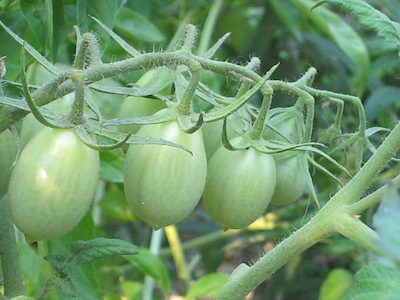
How to identify members of the nightshade family
Below are the means for identifying the plants as belonging to this family Solanaceae, venturing into some of the odd specialized language of plant physiology !
The Solanaceae are herbs, shrubs, or trees comprising about 85 genera and 2,800 species.
The leaves are alternate, usually simple, and lack stipules. The flowers are generally hermaphrodite (both sexes in one flower) though some are monoecious (in separate flowers) or dioecious (in separate plants), and pollinated by insects. The flowers can be solitary or grouped into various kinds of florescences. Many nightshade plants have a perfume or a fetid odour, but they can also be odourless.
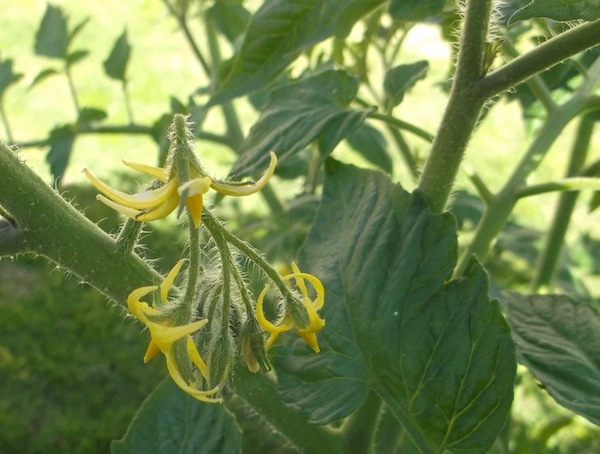 A tomato flower. Flowers help with placing nightshade plants into family and genera.
A tomato flower. Flowers help with placing nightshade plants into family and genera.The flowers of nightshade plants are actinomorphic (radially symmetrical) or only slightly zygomorphic (bilaterally symmetrical). The perianth (outer part with petals and sepals) and androecium (pollen producing ‘male’ part of flower) whorls generally are isomerous (have the same number of parts) and usually are 5- or sometimes 4- or 6-merous. These numbers are key in plant identification. The calyx (sepals, the very outermost whorl of a flower, usually green parts that cover the flower bud, and support the petal whorls when it is open) is synsepalous (fuzed at the base) , ranging from tubular to deeply cleft. The corolla is sympetalous (fuzed at the base) and ranges from forms with a short tube and rather long, reflexed lobes to forms with a long tube and short lobes (either a short tube with outward curved free parts, or a long tube with short free parts). The stamens are distinct (having free anther and filment, the stalk and the pollen bearing head of the stamens) alternating with the lobes of the corolla, and adnate to (fuzed to) the corolla tube or perigynous zone (area around the carpels, or female parts of the flower). The gynoecium (future fruit and seeds of plant) consists of a single compound pistil of 2 carpels, a single style, and a superior (above the base of the flower whorls) ovary with 2 or rarely more locules (compartments) by false partitioning, each with nearly always numerous axile ovules (placentas bearing seeds are in separate locules). A nectary disk (with gland producing sugary liquid) is generally present around the base of the ovary. The fruit is a berry (each flower develops into a fruit with the outer layer or pericarp of the ovary becoming fleshy or edible) or septicidal capsule (carpels of the syncaropous gynoecium separate when ripe, opening out to release seeds).
Well that was an interesting linguistic exercise revealing how every domain of human life has its own special language and vocabulary, some more so than others. If you are rigorous it can also help you identify a nightshade plant when you are not sure of the family.
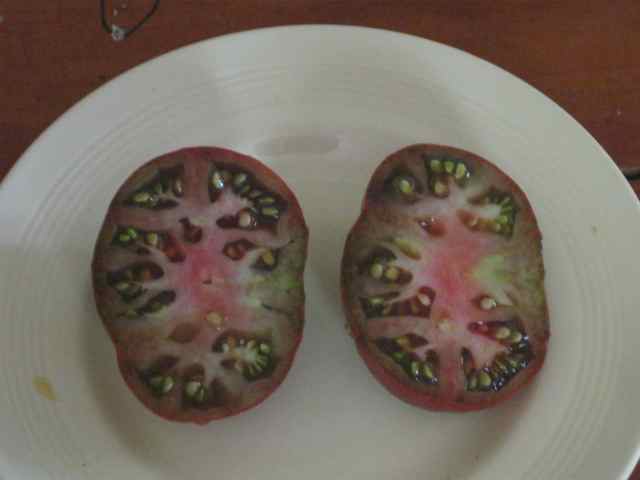 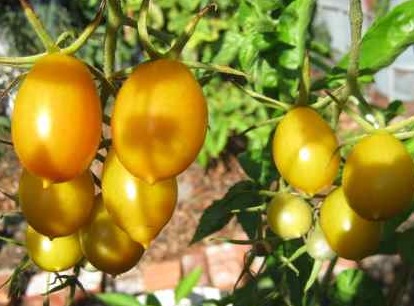 |
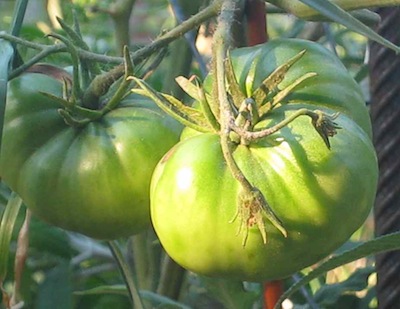  |
some of the different tomatoes in our garden
Nightshade vegetables
I think I will zoom in on the nightshade vegetables and food plants. I’ve mentioned tomatoes, potatoes, chilis and eggplant. They usually belong to the Solanoideae subfamily in which you find the deadly nightshade which also gave its name to the botanical order and family, and the genus in Latin, and to the family and particular plant in English. Covering poisons, medical drugs, hallucinogenics, staple and rarer foods and beautiful garden flowers, “Nightshades epitomise the power of human domestication to manage and exploit the diversity of plant life” (from the invitation to the 4th Annual Plymouth Linnean lecture on the 15th March, by the taxonomist Dr Sandra D. Knapp, Natural History Museum, London).
We mentioned earlier, three large subfamilies in the Solanaceae: the Solanideae, Nicotianoideae and Petunioideae there are also the Cestroideae, Goetzeoideae, Shizanthoideae and Schwenckioideae. We’ll run through them by subfamily.
Solinadeae, some of the most familiar nightshade plants
The Solinideae are the core nightshade plants that we know so well from the vegetable and flower garden and apothecary. Within this sub family are many a well known genus grouping.
Solanum
The genus Solanum and Capsicum are perhaps the best known for having produced a diverse selection of vegetables worldwide. We will run through the list in the genus Solanum just to lift you out of your slippers ! Working from under the ground up we have Solanum tuberosum (the potato), to above ground and plants eaten for their leaves: S. scabrum, S. villosum, S. nigrum, S. americanum (black or narrow leaf nightshade or Mnavu, see below), and finally plants whose fruit are the focus: S. lycopersicum, also known as Lycopersicon esculentum (tomato), S. melongena (eggplant also known as aubergine or brinjal), S. melanocerasum (garden huckleberry), S. muricatum (pepino melon), S. quitoense (naralnjillas, a hairy or smooth yellow persimon like fruit on a big bush with enormous lobed leaves, unknown in South Africa), S. sessiliflorum (the cocona, a large ovoid fruit of various shades of orange, with smaller leaves, unknown in South Africa), and S. centrale (Australian bush tomato, purple flowered, smooth pinnate leaf and small green, yellow or red fruit). Then there are the medicinals such as deadly nightshade, where there seems to be some polysemy as it can describe a number of species: in this genus there is Solanum dulmarca (more accurately woody nightshade). We will get to belladona later. See my Pinterest page for pictures.
One hears frequently that the leaves of nightshades are not eaten because they are full of toxic alkaloids. This is not strictly true, it depends on the species. I was surprised to find out that in Africa the leaves of some Solanum species are actually delicacies. The nightshade vegetables in Africa are very diverse, as are their chemical and nutritional qualities. Several species of Solanum, section Solanum, are grown for leaf vegetables in East Africa and West Africa particlarly Nigeria and Cameroon. There is large variety in the genus with medicinal properties. Some examples are Solanum scabrum (Australia) , S. villosum, S. nigrum, and S. americanum. The species with edible leaves generally have orange or black berries, and their common name in English may be black nightshade or narrow leaved nightshade. They are generally cooked as a vegetable and some varieties are bitter and some sweet, and the fruit are also eaten fresh. The leaves can be dried. It grows best in a cool and moist environment at high and medium altitudes, tolerates shade, but performs best in a sunny location in humus rich soil, with good phosphorus. It is not drought tolerant. Aphids, spider mite and early blight, like for all Solanaceae, provide setbacks.
Nightshade plants eaten for their leaves have many indigenous African names which appear to be distantly related linguistically, pointing to a deep history of their use, and perhaps the spread of the plants through human agency in the distant past. Some examples of these names in different languages follow (the language is in brackets) :
ormomoi (Maa), mnavu (Swahili), managu (Kikuyu),
namasaka (Luhya), osuga (Luo), ndunda (Taita),
nsugga (Luganda) isolyot (Kipsigis)
and kitulu (Kamba).
African nightshade plants are used as a medicine for ulcers, diarrhea, eye infections, jaundice, boils and swollen glands. It can serve as an iron supplement for nursing mothers and malaria patients.
The fruit and leaves can be used for dyes and the berries for ink. One well known species, Solanum nigrum, has black berries in a cluster. Its leaves are used as a vegetable, orginally seen as food for the poor, growing freely available and wild in the countryside, it was brought as a gift of wild food when country cousins visited towns folk. However it is now found in supermarkets in Kenya, due to research and NGO involvement in its horticultural and market development. The plant has a low leaf yield but is in very high demand. These vegetables are not known locally but I pinned some photographs on Pinterest.
Cyphomandra
This is the next genus, actually a sub section of the genus Solanum, which has produced a lot of edible fruit: Cyphomandra betacea (tree tomato or tamarillo, native to the Andes, and grown in Africa, including SA, India, Far East and New Zealand), and its relatives C. casana (Casana, with golden fruit), C. crassifolia and C. fragrans (Guava Tamarillo).
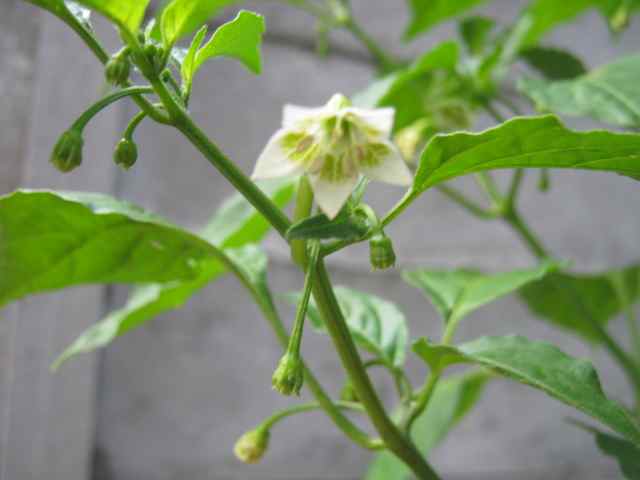 a chili flower a chili flower |
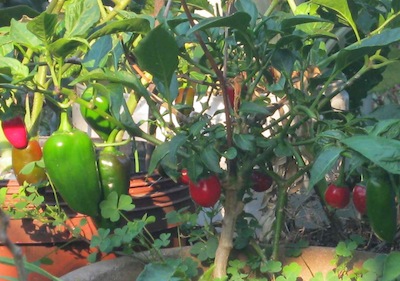 two kinds of chili fruit two kinds of chili fruit |
Capsicum
Capsicum is the best known peppery genus. Capsicum annuum has produced varieties with very varied appearance and taste, known by various names, such as bell pepper, paprika, cayenne pepper, pim(i)ento and chili. Other species in the genus are also peppery, such as C. frutescens (Tabasco pepper, Thai pepper, piri piri, malagueta, kambuzi (Malawian pepper), C. chinense (some of the hottest chilis, like Ato rodo (Nigeria), naga, habanero, datil and Scotch bonnet), C. pubescens (agi peppers from South America, peppadew and bishop’s crown).
Physalis
The genus physalis has fruit enclosed in a papery heart shaped capsule. Physalis peruviana is familiar to South Africans as the cape gooseberry, a small cherry sized orange fruit with warm flavor, but it is native to the Andes. The small fruit in this genus are generally known as ground cherries, and there are other species such as P. alkekengi which has spectacular scarlet capsules and a fruit tasting like a very sweet tomatillo. Which brings us to the large green fruit with a brownish husk, now known as tomatillo, P. ixocapra. It actually gave its name to the tomato (originally the xitomatl while the tomatillo was the tomatl) in the 16thC during a colonial name switch perpetrated by the Spanish for marketing reasons. It has an ancient history, was cultivated in pre Columbian Mexico before the tomato, and is ubiquitous in South and Meso American cooking, eaten raw or cooked such as in salsa verde. http://mexicanfoodjournal.com/salsa-verde. This vegetable is rare in South Africa, but I have pictures of all the genera of the nightshade plants discussed here on my Pinterest page (link at bottom of this article).
Tribe Lycieae
Lycium
Some of the Solanoideae have genus groupings known as tribes, for example the tribe Lycium and Hyschymeae. Known for their nutritional properties as super foods, but not to be consumed to excess are Lycium barbarum and L. chinense (the boxthorn, or wolf berry and goji berry). The decorative members of this genus are for example L. sandwicense, (‘ohelo kai) native to Hawaii.
Tribe Hyschymeae
We can move to the members of the sub family Solanideae which are better known for their pharmacological properties or the beauty and colour of their flowers. The tribe Hyschymeae includes the genus Hyoscymus and Atropa. Hyoscymus niger or henbane was a component in medieval European anaesthetics and an halucinogen and poison. Atropa belladonna (the deadly nightshade) is known for its production of Tropane alkaloids, that are halucinogens and deadly poisons, depending on the dose, and include atropine, scopolamine and hyoscyamine used to block a neuratransmitter acetylcholine that may be causing parasympathetic dysfunction, with symptoms from cardiac arrest to asthma, ulcers, insomnia and dizziness.
Tribe Datureae
Another tribe is Datureae, the trumpet flowers. This includes an invasive weed , or Jimsonweed, with thorny seed capsules Datura stramonium. Self medicators in search of a high regularly overdose with this plant, leading to fatalities.
Another genus in this tribe is Brugmansia, with B. candida, the white angel’s trumpet and B. suaveolens, the pink trumpet.
Scopolia
This genus contains Scopolia carniolica, or the mad herb, from which the medical drug scopolamine gets its name presumably.
Mandragora
This genus is the group of mandrakes: Mandragora officinarum, (Mediterranean mandrake of the classic European apothecary) , M. autumnalis (autumn mandrake) , M. caulescens (Himalayan mandrake) and M. turcomanica (Turkmenian mandrake). Mandrake’s properties and history deserve a separate article, and there is lots of information on the net, therefore I will not go into details here.
Lycianthes
Here we have some pretty flowers and a food. Lycianthes rentonnetii is the blue potato bush or Paraguay nightshade with its beautiful violet blue flowers. This small tree does really well in our neighbourhood and hence I often photograph it for my flower colour albums. The phylogenetic shuffle in botany coming after deeper research on plant properties has lead to the pepino or sweet cumumber, a low shrub bearing fruit the size of small melons, being placed in this genus despite its original name Solanum mucronatum.
Other Solanoideae
Let us close off the listing of well known plants in the Solanoideae, this sub family of Solanaceae, with some more lovely flowers. There is Nicandra physalodes with its pretty blue and white cups, and Iochroma (or Acnistus) australe with its violet blue two inch trumpets, and Acnistus arborescens a tree with clusters of small bright white trumpets.
We’re done with the close relatives of chilis and potatoes, the Solanoideae, and move on to those of tobacco, petunias, cestrum and some small lesser known sub families.
Nicotianoideae, comprised of decorative and addictive nightshade plants
Nicotiana
Another large sub family of the Solanaceae is the Nicotianoideae. The genus Nicotiana alone has 52 American species, 23 Australian and one African (modern Namibia). And it gave us a wonderful weed, Nicotiana tabacum, and N. rustica, or tobacco, containing one of the most addictive substances, nicotine, wonderful indeed. The genus also contains many garden flowers the majority of which are Australian. Tree tobacco, N. glauca is native to South America.
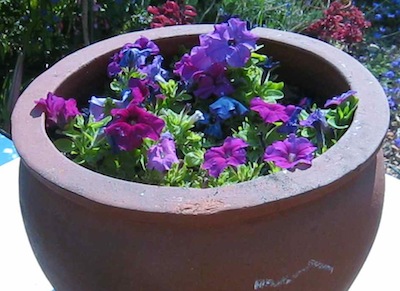 potted Petunias
potted PetuniasPetunioideae, including some of the most common nightshade plants in the garden
Petunia
The majority of plants in this family and genus are decorative. There is enormous diversity in colour in this genus which most gardeners will know.
Nierenbergia
Nierenbergia frutescens has a delicate white flower on a low shrub that can be trimmed to form a neat shape.
Brunsfelsia
Brunsfelsia latifolia, commonly known rather poetically as yesterday-today-and-tomorrow, is a small trainable tree or shrub with violet flowers that fade rapidly to white and an exquisite perfume.
Plowmania
Plowmania nyctaginoides has scarlet petals on a longish tube.
Cestroideae (Browallioideae)
The sub family Cestroideae contains the tribes Benthamielleae, Browallieae, Cestreae, Salpigollideae, and the rest of the unassigned Browallioideae.
Cestrum
Cestrum elegans is used as an ornamental, and has pom pom like clusters of smallish pink tubular flowers. There are many other colours in this genus such as gold and white.
Nothocestrum
Nothocestrum latifolium or ‘aiea, is a small tree native to Hawaii, found in dry forests at altitude. It has heart shaped leaves and tiny green flowers. There are three other species native to this chain of islands.
Salpiglossis
Salpiglossus sinuata is a herb or small shrub with a showy pink asymmetrical flower with red veins, but there is a lot of colour variation due to horticulturization.
little known nightshade plants, the Schwenckioideae
There are some more sub families of Solanaceae which I will just gloss over, because fatigue with all this marvelous diversity is setting in. I will leave the rest to be followed up by the enthusiatic reader. The sub family Schwenckioideae contains Heteranthia, Melananthus, Protoschwenckia and Schwenckia. There is so little information on these I could not even find pictures on google.
Schizanthoideae, a very gorgeous part of the nightshade family
This sub family has bilaterally symmetrical or zygomorphic flowers, with amongst other marvels, Schizanthus pinnatus dubbed the poor man’s orchid or butterfly flower.
Goetzioideae contains some lovely nightshade plants
This sub family contains the genera Coeloneurum, Espadeae, Goetzea, Henoonia, Metternichia and Tsoala. We have another surprise in terms of fruit and flowers.
Espedeae
Espedeae amoena has orange tubular flowers and yellow orange fruit. There is little information, except taxonomy and some photographs, on these plants. There is no clarification on whether these fruit are edible. It appears to be native to Cuba.
Henoonia
Henoonia myrtifolia has small hanging orange trumpets and golden fruit, perhaps also native to Cuba, otherwise there is little information.
Metternichia
Metternichia princeps is a dense compact tree, conical, with showy frilly edged, white stumpy trumpet type flowers with a powerful perfume. It has dehiscent seed pods . It is highly poisonous, causing kidney necrosis. It grows fast and can be used for course lightweight timber. There is some research on this plant, largely Portuguese, and I assume from the location of the fieldwork done, mainly from Brazilian botanists.
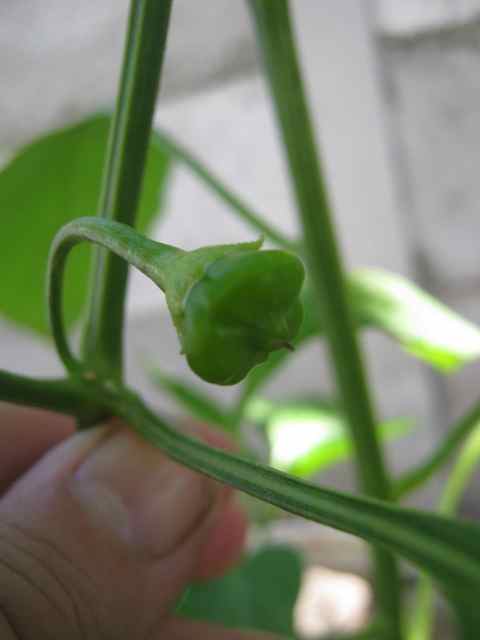 Nightshade plants lend themselves to breeding, as can be seen from all the diversity in a single genus, such as Capsicum. This is the hottest chili in the world, the Carolina Reaper !
Nightshade plants lend themselves to breeding, as can be seen from all the diversity in a single genus, such as Capsicum. This is the hottest chili in the world, the Carolina Reaper !------
home page for links to many green gardening ideas
------
------
a page of beautiful nightshade plants on pinterest
Restore Nature Newsletter
I've been writing for four years now and I would love to hear from you
Please let me know if you have any questions, comments or stories to share on gardening, permaculture, regenerative agriculture, food forests, natural gardening, do nothing gardening, observations about pests and diseases, foraging, dealing with and using weeds constructively, composting and going offgrid.
SEARCH
Order the Kindle E-book for the SPECIAL PRICE of only
Prices valid till 30.09.2023
Recent Articles
-
Rose
Dec 17, 23 04:08 AM
I am doing research on growing wildlife foraging plants to use in enhancement plantings with wildlife in mind. My thoughts after seeing bears too skinny -
Seeds for a bred Sweeter less acidic Kei apple
Nov 20, 23 03:24 AM
Greetings Greenidiom, I'm a small farmer in kenya. I'm looking to plant a Green fence around a 6 acre plot of land and, I'd wish to make it of kei apples -
Mrs Laura Robinson
Oct 08, 23 02:17 AM
How do I get a copy of the soil aggregation poster??
"How to start a profitable worm business on a shoestring budget
Order a printed copy from "Amazon" at the SPECIAL PRICE of only
or a digital version from the "Kindle" store at the SPECIAL PRICE of only
Prices valid till 30.09.2023
